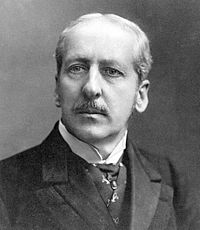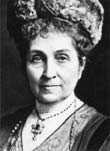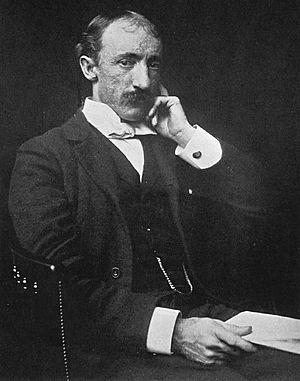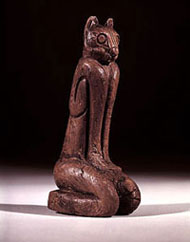Pepper–Hearst expedition facts for kids
The Pepper–Hearst expedition was an important trip to Florida in 1895-1897. It was paid for by Dr. William Pepper and Phoebe Hearst. An expert named Frank Hamilton Cushing led the team. They found amazing old objects from a time called the Shell Age. This showed how people lived long ago, before Christopher Columbus arrived.
Contents
Why the Expedition Started
In 1895, Dr. William Pepper heard about interesting old remains near Tarpon Springs, Florida. He decided to organize a trip to explore them. Phoebe Hearst, who was very generous, helped pay for the expedition.
They made a special deal with the Bureau of American Ethnology. This meant the expedition would be led by Frank Hamilton Cushing. He was a patient of Dr. Pepper's. The agreement also said that the Smithsonian Institution would get copies of any discoveries. They would also publish the scientific results. This important trip became known as the "Pepper–Hearst Expedition."
Cushing's First Look
In May 1895, Frank Hamilton Cushing started exploring. He had two helpers and a small fishing boat. They looked at islands and capes along the coast of Florida. They traveled about 90 miles south to a place called Key Marco.
At Key Marco, Cushing found a small, triangle-shaped pond. He called it the "Court of the Pile Dwellers." It was near the sea and surrounded by old shell mounds. Cushing thought people might have lived in houses built on poles over the water here.
Getting the Team Ready
After his first trip, Cushing returned. Dr. Pepper and his friends planned a bigger expedition for the next winter. Jacob Disston offered his schooner, the Silver Spray, for the journey. Major John Wesley Powell, who led the Bureau of American Ethnology, gave Cushing permission to go. He also promised official help for the expedition.
Funds were given to Cushing in November 1896. Wells M. Sawyer volunteered to be the artist and photographer. Irving Sayford agreed to be the Field Secretary. Carl F. W. Bergmann, an expert from the United States National Museum, also joined. The Clyde Line Steamship Company gave free passes for the team to travel. They left Washington on December 4, 1896. Cushing and his wife traveled separately and met the group in Jacksonville.
Digging at Key Marco
The Silver Spray ship set sail in February 1897. The crew included Sawyer, Sayford, and Bergmann. There were also sailors, excavators, a cook, and a steward. Cushing also hired other local workers to help with the digging.
When they arrived at Key Marco, Cushing arranged to keep all the objects they found. They started digging carefully, inch by inch, through the mud and rich soil. The team often worked in puddles of mud and water. After just one day, Cushing knew they would find amazing things.
They found relics that were both new and very interesting. Discoveries continued every day for five weeks. Cushing later said that even though the work was hard, he had never been so fascinated by anything.
The objects found were in different conditions. Some looked almost new, while others were hard to see in the muddy peat. They found things made of wood, rope, and other materials that usually rot away. They also found tools and ornaments made of shell, bone, and horn. Very few stone objects were found. Wooden items were the most common. Many of these had been painted with colors like black, white, blue, and reddish-brown. Cushing was worried that by digging up these unique items, they might accidentally destroy them. He wanted to preserve them as examples of ancient art.
Amazing Finds from the Past
The discoveries from before Columbus's time show a "Shell Age" culture. This means people used shells a lot for tools and other items.
Ancient Buildings
They found large pieces of wood, like a giant sill, that were still whole. These showed how skilled the ancient people were at joining wood together. Some broad, notched wooden pieces were found. Cushing thought these might have been used as special tablets. Perhaps they were attached to houses or altars. Flat boards sometimes stood upright, and other long, thin items were stuck in the clay at the bottom.
Objects from Daily Life
They found seats made from flat wooden slabs. These were about 1 to 2 feet long and slightly hollowed on top. They had rounded bottoms and sturdy, prong-like feet. Some stools had flat feet, while others had angled feet to fit into canoes.
They also found parts of mats. Some were thick, like rugs. Others were wrapped around objects. Some were made of thin, flat strips of bark woven so tightly they might have been used as sails. Sadly, none of these mats could be saved. However, it was clear that the people knew how to weave and make baskets very well.
A few pieces of pottery were found. These looked like they had been used as cooking bowls or pots. Along with them were household tools. These included spoons made from shells and ladles made from large conch shells. They also found wooden cups, bowls, trays, and mortars. The trays were shallow and oval-shaped. Their ends were narrowed to form handles, often decorated with carved designs.
They found Atlatls (spear-throwers) and arrows, but no bows. There were many different kinds of war clubs. They also found dirks, which are small daggers, made from deer leg bones. The expedition also discovered personal ornaments, ceremonial objects, carvings, paintings, masks, and figureheads.
What Happened Next
The discoveries at Key Marco and Demorey Key were very exciting. They showed that ancient Floridians had lived in houses built on poles over the water. They also had a very advanced civilization.
The original collection of artifacts was displayed at the University of Pennsylvania Museum of Archaeology and Anthropology. A second set of representative items was shown at the National Museum in Washington. Sadly, Frank Hamilton Cushing passed away before he could publish his full report on the expedition.






